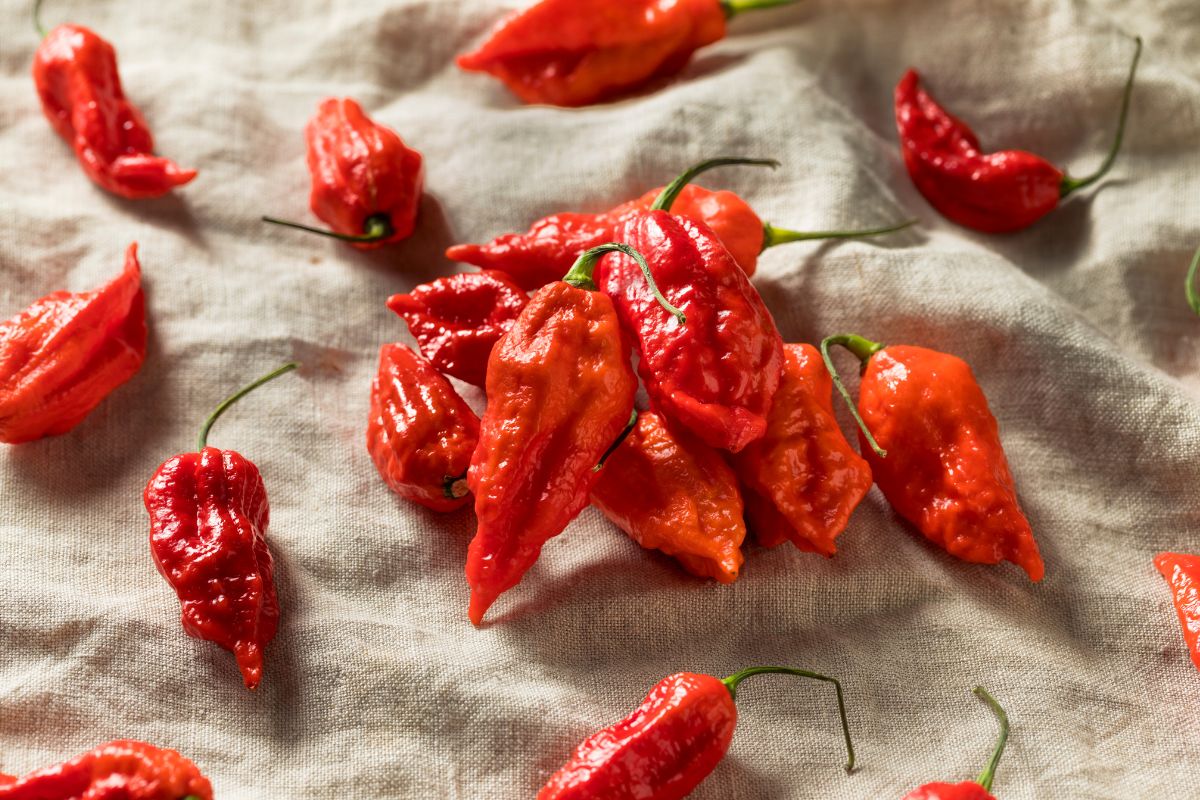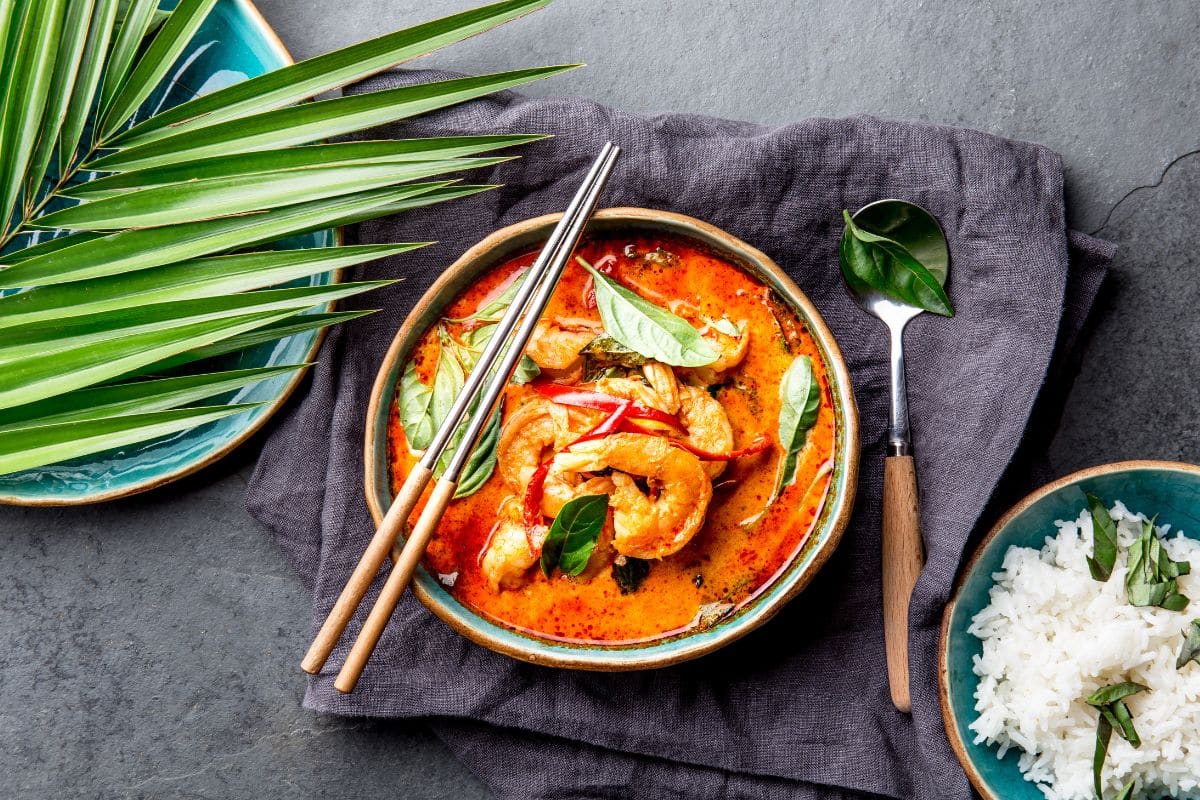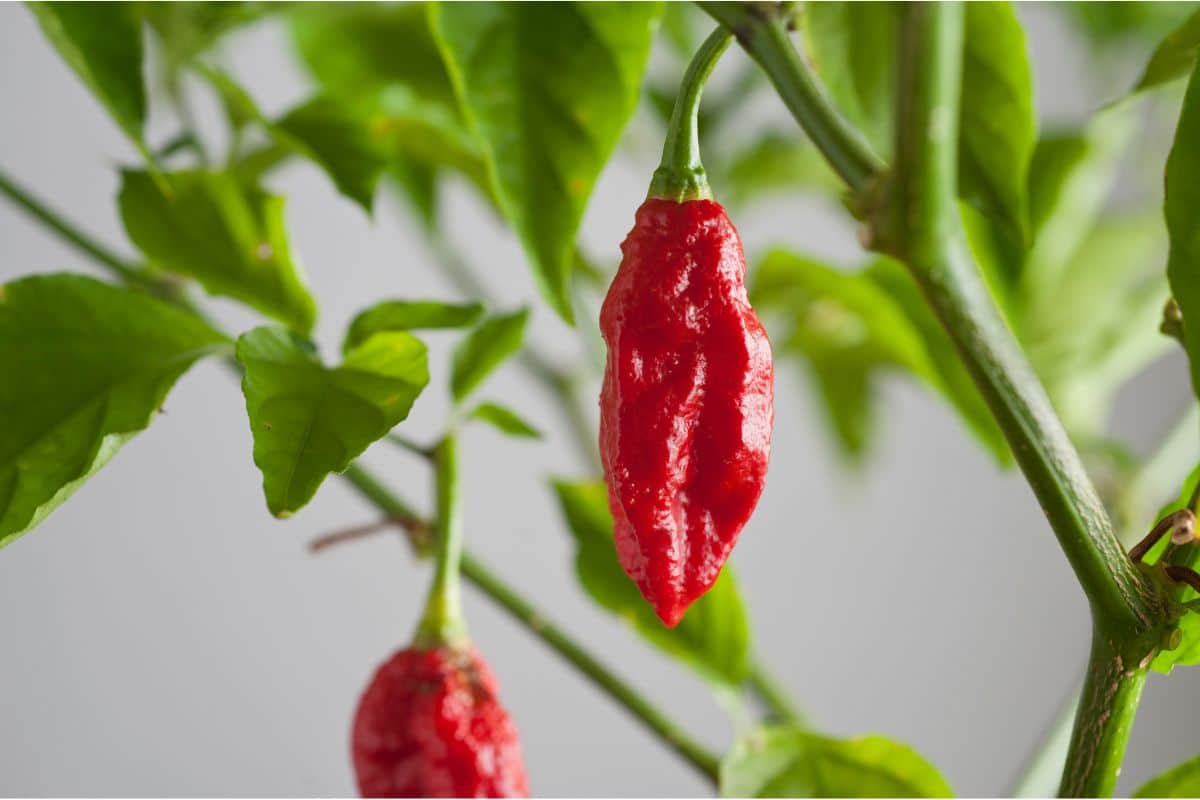The ghost pepper is one of the world’s spiciest peppers and has been gaining popularity among spicy food lovers around the globe.

Originally from India, this chili pepper has gained a reputation for its intense heat and unique flavor profile.
In this article, we will explore everything you need to know about the ghost pepper, from its history and cultivation to its uses in cuisine and health benefits.
So get ready to get spicy as we dive into everything you need to know about the ghost pepper!
What Is The Ghost Pepper?
The bhut jolokia, or ghost pepper, is a chili pepper native to Northeast India.
It is one of the hottest peppers in the world, with a Scoville rating (referring to the unit of measurement used to dictate the heat of a pepper) that can range from 800,000 to over 1,000,000 Scoville units.
Let’s put that into perspective a little bit. A jalapeño pepper tends to have a Scoville rating of around 2,500 to 8,000 units, making the ghost pepper up to 400 times hotter!
The ghost pepper is named for its ghostly bite and is characterized by its wrinkled, red-orange skin and tapered shape.
It has a unique flavor profile that is both sweet and fruity, with a hint of smokiness. The heat of the ghost pepper is intense and can linger on the palate for several minutes after consumption.
The History Of The Ghost Pepper
The ghost pepper has a long and fascinating history that dates back several centuries. The pepper originates from Northeastern India and was traditionally used in local cuisine and as a means of self-defense against wild animals.
It was also believed to have medicinal properties and was used to treat a range of ailments, from stomach aches to the common cold.
In the early 2000s, the ghost pepper gained international attention when it was declared the world’s hottest pepper by the Guinness World Records. Its popularity skyrocketed, and it became a sought-after ingredient among spice enthusiasts and hot sauce makers around the world.
Today, the ghost pepper is widely cultivated in India and is also grown in other countries such as Bangladesh, Sri Lanka, and the United States.
It has become a staple ingredient in many spicy dishes, including curries, chutneys, and hot sauces. Despite its intense heat, the ghost pepper continues to captivate and intrigue spice lovers around the world.
The Cultivation Of The Ghost Pepper
The ghost pepper is primarily cultivated in Northeast India, particularly in the states of Assam, Nagaland, and Manipur. It is a tropical plant that thrives in hot and humid conditions, and it requires well-drained soil and plenty of sunlight.
The ghost pepper plant is a perennial shrub that can grow up to four feet tall. It produces small, white flowers that eventually give way to the pepper pods.
These pods typically mature to a bright red or orange color and can range in size from one to three inches in length.
The ghost pepper plant is highly adaptable and can be grown both in the ground and in containers. It requires regular watering and fertilization, and the peppers are typically harvested when they are fully matured.
Due to the intense heat of the ghost pepper, it is important to handle the plants with care and to use protective gloves when harvesting the peppers.
The peppers can also be dried and ground into a fine powder, which is often used as a spice in cooking and seasoning.
How Is The Ghost Pepper Used In Cuisine?
The ghost pepper is primarily used as a spice in cuisine, adding heat and flavor to a range of dishes.
In Northeast India, where the ghost pepper is native, it is commonly used in curries, chutneys, and pickles. It is also used to flavor meat dishes, such as pork and chicken, and is sometimes added to desserts for a spicy kick.
In other parts of the world, the ghost pepper has become a popular ingredient in hot sauces and spice blends. It is often used in combination with other peppers and spices to create complex and flavorful sauces that pack a powerful punch.
Some hot sauce makers even specialize in creating sauces made exclusively with ghost peppers.
The ghost pepper is also used in the production of pepper spray and other non-lethal weapons, due to its intense heat and irritant properties.
It is important to note that the ghost pepper is extremely hot and should be used in moderation, as it can easily overpower other flavors in a dish.
When cooking with ghost peppers, it is recommended to handle them with gloves and to use caution when handling and chopping them, as the capsaicin in the peppers can cause skin irritation and burning sensations.
How To Cook With Ghost Peppers
When cooking with the ghost pepper, it is important to handle it with care and use it in moderation, as its heat level can easily overwhelm a dish. Here are some tips for cooking with ghost peppers.
Use Gloves
Wear gloves when handling ghost peppers to avoid getting the capsaicin oil on your skin, which can cause a burning sensation.
Remove The Seeds
The seeds of the ghost pepper contain the highest concentration of capsaicin, so remove them before using the pepper in a dish. You can do this by cutting the pepper in half and scraping out the seeds with a spoon.
Use Sparingly
Ghost peppers are extremely hot, so use them in small quantities to avoid overpowering the other flavors in a dish. You can add them to a dish in the form of a purée or finely chopped.
Pair With Complementary Flavors
The fruity and smoky flavor of the ghost pepper pairs well with citrus, vinegar, and herbs like cilantro and basil. Use these flavors to balance out the heat of the pepper.
Be Cautious When Cooking
The fumes from cooking with ghost peppers can be strong and can cause respiratory irritation, so make sure to cook in a well-ventilated area.
By following these tips, you can add the unique and intense flavor of the ghost pepper to your dishes without overwhelming your taste buds with heat.
Ghost Pepper Dishes

Ghost peppers are primarily used to add heat to dishes, but they also add a distinctly fruity and smoky flavor. Here are some popular dishes that use ghost peppers.
Ghost Pepper Curry
This is a traditional Northeast Indian dish made with ghost peppers, chicken or lamb, onions, tomatoes, and a blend of spices. It is typically served with rice or flatbread.
Ghost Pepper Hot Sauce
This hot sauce is made by blending ghost peppers with vinegar, garlic, and other spices. It can be used as a condiment on a variety of dishes, from tacos to eggs.
Ghost Pepper Salsa
This salsa is made with tomatoes, onions, cilantro, and ghost peppers. It is a great addition to grilled meats and fish.
Ghost Pepper Jerky
This is a popular snack that is made by marinating beef or venison in a mixture of ghost pepper powder, soy sauce, Worcestershire sauce, and brown sugar. The meat is then dried to make a chewy and spicy snack.
Ghost Pepper Chocolate
This is a unique dessert that combines the heat of the ghost pepper with the sweetness of chocolate. It is made by adding ghost pepper powder to melted chocolate and then pouring it into molds to set.
Ghost Pepper Chicken Wings
Chicken wings coated in a spicy ghost pepper sauce, and then baked or fried until crispy. These wings are perfect for game day or as a spicy snack.
Ghost Pepper Chili
A hearty and spicy chili made with ground beef, beans, tomatoes, and ghost pepper. This dish is perfect for warming up on a cold winter day.
These dishes are not for the faint of heart, as ghost peppers are extremely hot. However, for those who can handle the heat, they offer a unique and flavorful culinary experience.
The Ghost Pepper Vs The Carolina Reaper
The ghost pepper and the Carolina Reaper are both extremely hot chili peppers and are among the hottest peppers in the world. However, the Carolina Reaper is currently considered the hottest pepper in the world by the Guinness World Records.
On the Scoville Scale, the Carolina Reaper ranges from 1.4 to 2.2 million Scoville Heat Units (SHU), while the ghost pepper ranges from 855,000 to over 1 million SHU, as mentioned above.
This means that the Carolina Reaper is significantly hotter than the ghost pepper. The Carolina Reaper has a sweet, fruity flavor with a very intense and long-lasting heat.
Both peppers should be handled with care, as they can cause intense irritation and discomfort if not handled properly.
It is important to use caution when consuming either of these peppers and to start with small amounts if you are not accustomed to spicy foods.
The Ghost Pepper Vs The Trinidad Moruga Scorpion
On the Scoville Scale, the Trinidad Moruga Scorpion ranges from 1.2 to 2 million Scoville Heat Units (SHU), meaning that the Trinidad Moruga Scorpion is generally considered to be hotter than the ghost pepper.
The Trinidad Moruga Scorpion has a fruity, floral flavor and is another pepper with a very intense and long-lasting heat, while the ghost pepper has a more earthy, smoky flavor with a relatively shorter-lasting heat.
The Possible Health Benefits Of The Ghost Pepper

While ghost peppers are primarily known for their intense heat, they also have a number of possible health benefits. Here are some of the potential health benefits of ghost peppers.
Pain Relief
The capsaicin in ghost peppers can act as a natural pain reliever. It has been shown to help relieve pain associated with arthritis, neuropathy, and headaches.
Boosts Metabolism
Capsaicin is known to increase metabolism and promote fat burning, which can help with weight loss.
Anti-Inflammatory Properties
Capsaicin has anti-inflammatory properties, which can help reduce inflammation in the body and lower the risk of chronic diseases like heart disease and cancer.
Immune System Support
The vitamin C content in ghost peppers can help support the immune system and protect against infection.
It is important to note that ghost peppers should be consumed in moderation, as their heat can cause digestive discomfort or even allergic reactions in some individuals.
It is also important to consult a healthcare provider before adding ghost peppers to your diet, especially if you have any underlying health conditions or are taking medication.
The Potential Dangers Of The Ghost Pepper
While the ghost pepper offers potential health benefits, it can also be dangerous if consumed in large quantities or by those who are sensitive to spicy foods.
Let’s take a look at some of the possible dangers that come with consuming the ghost pepper.
Mouth And Throat Irritation
The intense heat of the ghost pepper can cause irritation and even damage to the mouth and throat when consumed in large amounts.
Digestive Issues
The capsaicin in ghost peppers can also cause digestive discomforts, such as stomach pain, diarrhea, and nausea.
Individuals with sensitive digestive systems or digestive disorders may be more susceptible to these effects.
Allergic Reactions
Some individuals may be allergic to ghost peppers, which can cause symptoms such as itching, hives, swelling, and difficulty breathing.
Skin Irritation
Ghost peppers can also cause skin irritation if they come into contact with the skin, especially if the skin is broken or sensitive.
Misuse
It is also worth noting that misuse of ghost peppers, such as intentionally inhaling the powder or getting it in the eyes, can cause severe pain and even blindness.
Final Thoughts
The ghost pepper is an incredibly hot chili pepper with a long history and an impressive heat level.
It has been used in traditional Indian and Southeast Asian cuisine for centuries and is now gaining popularity in other parts of the world as well.
While the ghost pepper offers a range of potential health benefits, it should be handled with care due to its extreme heat level, and caution should be taken when consuming it.
Whether you are an experienced chili pepper enthusiast or just curious about the world of spicy foods, the ghost pepper is a fascinating ingredient to explore.






